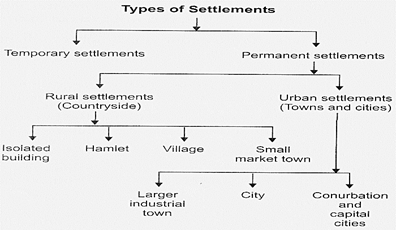Fundamentals of Human Geography Book – 01
CHAPTER NO. 10
HUMAN SETTLEMENTS
Very Short
Answer type questions. (Important
Questions)
Q1. Who coined the term conurbation?
Ans. Patrick Geddes in 1915.
Q2. When London became the first million city?
Ans. In 1800.
Q3. Which form of settlement develops along either side of roads?
Ans. Linear.
Q4. What is urbanization?
Ans. The gradual
increase in the proportion of people living in urban areas.
Q5. Name any one million plus city from Africa.
Ans. Cairo (Egypt) and Lagos (Nigeria).
Q6. In which year Addis Ababa was established.
Ans. 1878, Ethiopia.
Q7. Who prepared the plan of Canberra city?
Ans. American
landscape architect, Walter Burley Griffin (1912).
Q8. What is a healthy city?
Ans. A healthy city refers to the city having a
clean & safe environment, meets the basis need of all its inhabitants,
involves the community in local government, provides easily accessible health
service.
Q9.Which is the largest city in the world in terms of population?
Ans. Tokyo ( Japan
).
Q10.What are the two main types of Settlement?
Ans.
Urban and Rural.
Q11. Name the factor on the basis of which the village are separated
from town?
Ans.1. Size of
population.
2.
Economics.
3.
Administrative.
Q12. What is the other name of compact settlement?
Ans. Nucleated settlement.
Q13. What is Rural Settlement?
Ans. Rural
Settlement is most closely and directly related to land. Rural settlement are
small in size population resides in a village. They are dominated primarily activities.
Example:- agriculture, animal Husbandry, Fishing, and etc.
Q14. Which factor affecting the local of rural settlement?
Ans.1.Water supply,
2.
Land,
3.
Upland,
4.
Building material
5.
Defence .
Q15. Name the country with 100% urban population?
Ans. Singapore .
Q16. What percentage of the urban population is found in developing
countries?
Ans.
40%.
Q17. What should be the density of population in urban Settlement?
Ans.400 per sq.km.
Q18. Why do people in south East Asia choose to live near low lying
areas?
Ans. Because there
suit wet rice cultivation.
Q19. What is mega city?
Ans. Metropolitan area with more than one Crore people is called Mega City. 10 million or 1 Crore.
Q20. How much population live in urban areas?
Ans. 52.6%.
Q21. Which city was first to attain the status of a mega city &
when?
Ans. New York in 1950.
Q22. Name one million city & one mega city?
Ans. London & New York.
Q23. Name the type of urban settlement on the basis of size &
services available & functions.
Ans. 1.Town,
2.
City,
3.
Conurbation,
4.
Million city,
5.
Megalopolis.
Q24. Name the major types of rural settlement on classification by
shape.
Ans. 1. Compact settlement.
2.
Dispersed settlement.
3.
Helmeted settlement.
Q25. Name the type of urban settlement according to function.
Ans. 1.Administrative
town,
2.
Cultural town,
3.
Historical town,
4.
Industrial town.
5.
Transport town (E.g.Singapore).
Q26. What are the problems of human settlement in developing country?
Ans. i. Lack of
drinking water facility.
ii.
Lack of infrastructure.
iii.
Health problem.
iv.
Lack of Education.
Q27. Name any three types of rural settlement pattern?
Ans. i. line
pattern,
ii.
Rectangular ,
iii.T-shape,
iv.
Star shapes,
v.
Y-Shape.
Q28. What is Sub-Urbanisation?
Ans. It is a new
trend of people moving away from congested urban areas to cleaner areas outside
the city in search of a better quality of living.
Q29. What is the wet point?
Ans. It refers to
the sites which are close to a supply of water.
Q30. What is the dry point?
Ans. A dry point is
an area of firm or flood free ground in an area of wet land marsh and flood
plain.
Q31. What are the major problems of rural and urban areas?
Ans.
1. Rural areas problem: 1. Lack of Literacy. 2. Lack of health service. 3. Employment. 4. Lack of Transport.
2. Urban areas problem: 1. Lack of drinking Water 2. Seawrage problems. 3. Pollution.
Q32. Give example of any two Cultural towns in the world.
Ans.
Jerusalem,
Mecca, and Varanasi.
Q33. Give example of any two Trading and Commercial Towns in the world.
Ans. 1. Banking and
financial city:- Frankfurt and
Amsterdam.
2.
Agricultural market town:- Winnipeg.
Q34. Give example of any two Planned City in the world.
Ans.1.Chandigarh.2.
Canberra.
Q35. Give example of any two Industrial City in the world.
Ans. Pittsburgh and Jamshedpur.
Q36. Give example of any two health’s and Recreation City in the world.
Ans.
Miami
and Panaji.
Q37. Who coined the term megalopolis?
Ans. Jean Gottman in 1957.
Q38.What is Conurbation?
Ans.
A
large area of urban development that resulted from the merging of originally
separate towns or cities. Greater London, Manchester,
Q39. Name the type of rural settlement Patterns On the basis of
functions?
Ans.
Farming villages, fishermen’s villages,
lumberjack villages, pastoral villages.
Q40. Distinguish between rural and urban settlements.
Ans. Rural settlements- Primary activities are main
occupation in these settlements and 75% population is engaged in primary
occupation. Population sizes are is low in these settlements.
Urban settlements- Non-agricultural work is the main
occupation in these settlements and 75% population is engaged in these
activities. Population Size is large in these settlements.
Q41. What are the priorities outlined by the UNDP as a part of its urban
strategy.
Ans. Increasing
Shelter for the urban poor, Provision
of basic urban services such as education, Primary Health Care, Clean Water and
Sanitation, Improving women's access to Basic Services and government
facilities.
Q42. What
are three criteria in India to consider a settlement as an urban settlement?
Ans. (1) Minimum
population of 5000 person, the density 400 person/sq. km.
(2) 75% of the population should be
engaged in secondary activity sand services.








0 Comments
Post a Comment
Please do not enter any spam link in the comment box.